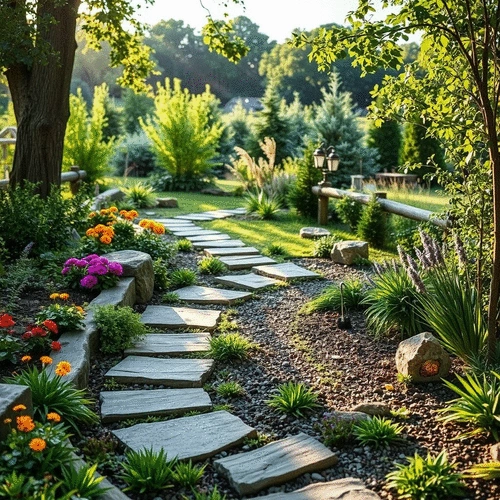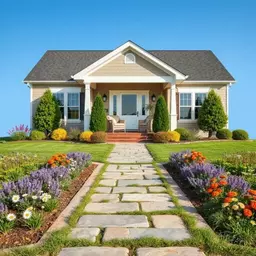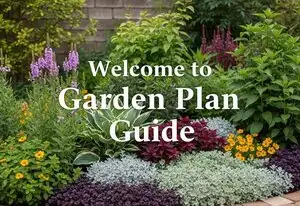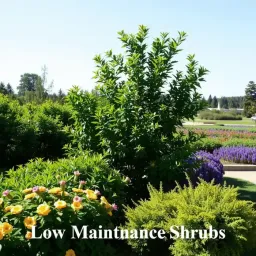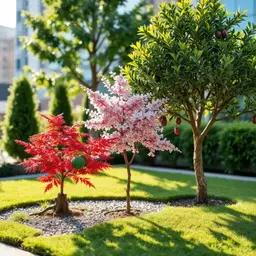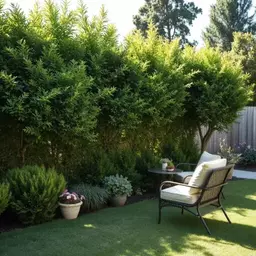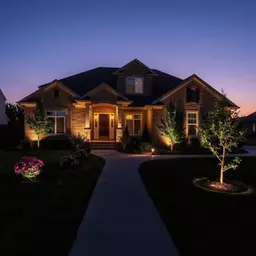Did you know that a well-designed garden path can transform an ordinary outdoor space into an enchanting landscape? Creating inviting outdoor spaces with DIY garden paths is an art in itself, blending functionality with aesthetics. Whether you're looking to enhance accessibility or add a personal touch, this guide will equip you with the knowledge and inspiration needed to embark on your gardening journey!
What You Will Learn
- The importance of garden paths in enhancing beauty and accessibility in outdoor spaces.
- Benefits of DIY garden paths, including customization, cost savings, and a rewarding sense of accomplishment.
- Different materials for building garden paths, such as gravel, flagstone, reclaimed brick, and their unique advantages.
- Key features to consider for designing accessible paths that cater to all abilities, including width, surface texture, and drainage.
- The value of engaging with the DIY community for inspiration, sharing experiences, and showcasing innovative designs.
- Encouragement and practical tips to start your DIY garden path project and create a welcoming outdoor space for everyone.
Benefits of DIY Garden Paths Compared by Material
Explore the key advantages of different materials used in DIY garden paths. The following visual highlights customization, cost savings, and ease of installation for various options.
Gravel
- Customization: Flexible design options.
- Cost Savings: Affordable and easy to install.
- Natural Look: Blends seamlessly with garden.
Flagstone
- Customization: Natural aesthetics enhance gardens.
- Durability: Sturdy and weather-resistant.
- Maintenance: Low maintenance option.
Reclaimed Brick
- Customization: Unique character from each brick.
- Durability: Long-lasting and resistant.
- Sustainability: Eco-friendly choice.
Mulch
- Customization: Natural look complements plants.
- Eco-Friendly: Supports ecosystem health.
- Aesthetic Appeal: Soft surfaces enhance beauty.
Creating Inviting Outdoor Spaces with DIY Garden Paths
Have you ever strolled through a garden and felt enchanted by the paths that guide your way? Garden paths do more than just connect different areas of your outdoor space—they play a crucial role in landscaping by enhancing both beauty and accessibility. Imagine how a well-placed path can draw the eye and invite you to explore, creating a sense of flow and organization in your garden! Just like a beautiful path, carefully selected trees can also enhance curb appeal, guiding the eye and adding structure to your landscape.
Understanding the Importance of Garden Paths
Garden paths are essential components in any landscape design. Not only do they provide a clear route through your garden, but they also serve to define spaces, helping to separate different areas of your yard. Think about it: a winding path can lead to a hidden nook or a vibrant flower bed, adding an element of surprise to your outdoor adventure.
Furthermore, well-constructed paths enhance accessibility, making it easier for everyone to enjoy the beauty of your garden. Whether you have children playing, older family members visiting, or simply want to navigate your space comfortably, having a defined path can make all the difference!
Exploring the Essentials of DIY Garden Paths
Building your own garden path can be a rewarding DIY project, and it offers a chance to infuse your personal touch into your landscape. DIY garden paths are flexible in terms of design and materials, allowing you to create something unique that complements your home and garden. Plus, it’s often more cost-effective than hiring a professional! For those interested in other DIY landscaping projects, learning about a beginner's guide to garden layout can provide a strong foundation.
Let’s explore some of the benefits of choosing a DIY approach for your garden path:
- Customization: You can choose materials and designs that perfectly match your garden's style.
- Cost Savings: DIY projects can save you money while still achieving stunning results.
- Sense of Accomplishment: There’s nothing quite like seeing your hard work pay off as you stroll down your newly created path.
At Garden Plan Guide, we believe that every homeowner has the potential to create a beautiful outdoor space. So, grab your tools and let’s get those creative juices flowing!
Materials for Building DIY Garden Paths
Choosing the Right Material for Your Garden Path
When it comes to building a garden path, the material you choose plays a significant role in the overall look and durability. Several popular options cater to different tastes, budgets, and garden styles. Here’s a quick overview of the top materials you can consider:
- Gravel: Affordable and easy to install, perfect for casual paths.
- Flagstone: Offers a natural, rustic look with excellent durability.
- Brick: Timeless and charming, especially when using reclaimed options.
- Mulch: Eco-friendly and blends well with natural surroundings.
Choosing the right material not only impacts the aesthetic appeal but also influences how well the path will stand up to the elements. Make sure to consider your garden's style and your maintenance preferences when selecting the best option for you!
The Benefits of Gravel Pathways
Gravel pathways are undoubtedly one of the most popular choices for DIY projects, and for good reason! One major advantage is their affordability, making it easy to create stunning paths without breaking the bank. Plus, gravel allows for excellent drainage which helps prevent puddles and mud during rainy seasons.
Some additional benefits include:
- Easy Installation: You can lay a gravel path quickly with minimal tools.
- Versatile Design: Gravel can be used in various patterns and styles.
- Natural Look: It blends seamlessly into most garden environments.
Using Flagstone for Durable Walkways
If you're looking for aesthetics combined with longevity, you can’t go wrong with flagstone. This material offers a beautiful, natural appearance that can enhance any garden design. Flagstone is also sturdy and weather-resistant, ensuring your path lasts through the seasons!
Imagine a flagstone path winding through your flower beds, creating a picturesque view. It's a great choice for those who want a low-maintenance option that still looks elegant.
Reclaimed Brick: A Sustainable Option
For an eco-friendly choice, consider using reclaimed bricks. Not only do they add character to your garden, but they also represent a sustainable practice by reusing materials. The warm tones of brick can create a charming and inviting atmosphere, making your garden feel like a cozy retreat.
Some perks of using reclaimed brick include:
- Charming Aesthetic: Each brick has its own unique history and personality!
- Durability: Bricks are built to last and resist wear and tear.
- Environmentally Friendly: Reusing materials reduces waste and supports sustainability.
Choosing Between Pavers and Stepping Stones
Pavers and stepping stones can add a lot of character to your garden paths. Pavers allow for a smooth, even surface, making them suitable for high-traffic areas. On the other hand, stepping stones can be arranged in creative patterns, giving your path a whimsical feel.
Consider these aspects when choosing:
- Usage: For areas with heavy foot traffic, pavers may be best.
- Design Flexibility: Stepping stones offer more creative options.
- Ease of Installation: Both options are relatively easy to install with proper preparation.
Utilizing Mulch and Wood Chips for Natural Paths
Mulch and wood chips are excellent choices for creating a natural look that supports your garden's ecosystem. They provide soft surfaces that are easy on the feet and help retain soil moisture. Plus, organic materials can decompose over time, adding nutrients back into the soil!
Some benefits of using mulch include:
- Eco-Friendly: It promotes healthy soil and plant growth.
- Weed Control: Helps suppress unwanted weeds in your garden.
- Aesthetic Appeal: A natural look that blends beautifully with plant life.
Now that we've covered the materials, you're one step closer to creating the perfect garden path that reflects your style and enhances your outdoor space. Let your imagination run wild and enjoy the process of bringing your garden to life!
Quick Summary
- Importance of Garden Paths: They enhance landscaping, improve accessibility, and guide visitors through your space.
- DIY Benefits: Creating your own garden paths allows for customization, cost savings, and a rewarding sense of accomplishment.
- Material Choices: Consider various materials like gravel, flagstone, and reclaimed brick to suit your garden's style and needs.
Incorporating Accessibility in Garden Path Designs
Creating a garden that everyone can enjoy is so important! It’s essential to think about accessibility when designing your garden paths. I often encourage homeowners to consider how their outdoor spaces can be welcoming to people of all abilities. With a few thoughtful adjustments, your garden can become a place where everyone can move freely and safely. For more ideas on how to improve your outdoor space, consider simple patio landscaping ideas.
When we think about accessibility, it’s helpful to keep in mind some key features. Wider paths, gentle slopes, and non-slip surfaces are all critical elements. Consider also incorporating resting areas along longer paths, providing seats where visitors can take a break and enjoy the beauty of your garden. Here are some tips to make your paths accessible:
- Ensure paths are at least 36 inches wide for easy navigation.
- Opt for textured materials to prevent slipping, especially when wet.
- Incorporate gradual slopes instead of steep inclines for easier access.
- Add clear signage to guide visitors through the garden.
Designing Paths for All Abilities
Designing paths that cater to various abilities doesn’t have to be complicated! It’s all about creating a plan that focuses on inclusivity. Start by assessing the needs of your family and guests. Think about who will be using the garden and how you can make it more accessible. Here are some key considerations:
- Choose materials that provide a stable surface, like compacted gravel or pavers.
- Incorporate gentle curves instead of sharp turns, making navigation easier.
- Ensure appropriate drainage to minimize puddles and muddy areas.
By implementing these ideas, you’ll create a path that not only looks beautiful but is also functional and accessible. Remember, a well-designed path can enhance the overall experience of your garden, making it a welcoming space for everyone!
Engaging with the DIY Community
Joining the DIY gardening community is one of the most rewarding aspects of this journey! Sharing experiences, tips, and stories can inspire both you and others. At Garden Plan Guide, we love hearing from fellow DIY enthusiasts and seeing how they’ve tackled their own garden projects. Your journey could motivate someone else to start theirs! You might also find inspiration in building your own rock garden.
Showcasing User Testimonials and Experiences
Real-life stories from the community often spark ideas and creativity. When I receive testimonials, I’m always amazed at the transformative power of gardening! Here are some inspiring experiences shared by our readers:
- A homeowner who created a beautiful gravel path that doubled as a rain garden, effectively managing water runoff.
- A family that built a wheelchair-friendly walkway with wide pavers, allowing their grandmother to enjoy the garden for the first time in years.
- A DIY enthusiast who incorporated natural plantings along their path, blending accessibility with beauty.
These stories not only highlight the creativity of our community but also show that gardening can truly be for everyone! Don’t hesitate to share your own journey with us—we’d love to feature your projects!
Creating a Community Around DIY Garden Projects
Engaging with others who share your passion can be incredibly motivating! I encourage readers to share their DIY garden path projects, whether big or small. You can join forums, social media groups, or even comment on our blog posts! Together, we can build a vibrant community that supports and inspires one another.
Highlighting User-Generated Designs and Innovations
One of the best parts of the DIY community is the innovative designs that come from its members. I love featuring unique garden paths submitted by readers! From creative uses of materials to stunning arrangements, each design adds a fresh perspective. If you’ve designed something special, send it my way—let’s inspire others together!
FAQ: Creating Inviting Outdoor Spaces with DIY Garden Paths
Here are some frequently asked questions about creating DIY garden paths:
- Why are garden paths important?
Garden paths are crucial for enhancing landscaping by defining spaces, improving accessibility, and guiding visitors through your outdoor area. They add both beauty and functionality. - What are the benefits of building a DIY garden path?
DIY garden paths offer customization to match your garden's style, significant cost savings compared to hiring professionals, and a rewarding sense of accomplishment. - What materials can I use for a DIY garden path?
Popular materials include gravel (affordable, easy to install), flagstone (durable, natural aesthetic), reclaimed brick (sustainable, charming character), pavers, stepping stones (design flexibility), and mulch or wood chips (eco-friendly, natural look). - How can I make my garden path accessible for everyone?
To ensure accessibility, design paths to be at least 36 inches wide, use non-slip and stable materials like compacted gravel or pavers, incorporate gradual slopes instead of steep inclines, and consider adding resting areas along longer paths. - How can I get inspiration and support for my DIY garden path project?
Engage with the DIY gardening community by joining forums, social media groups, or sharing your projects. You can find inspiration from user testimonials and innovative designs shared by others.
Encouragement to Start Your DIY Garden Path Journey
As we wrap up our discussion on creating inviting garden paths, I hope you feel inspired to start your own project. Remember, accessibility, community engagement, and a touch of creativity can transform your garden! Whether you choose gravel, flagstone, or reclaimed brick, your path will tell a story and invite others to explore. For those looking to further enhance their garden's appeal, understanding plants that boost curb appeal can be a great next step.
Let’s get started on making your outdoor space a welcoming haven for everyone. Your garden journey awaits—grab your tools and let the creativity flow! If you have any questions or want to share your progress, I’m just a comment away. Happy gardening!
Recap of Key Points
Here is a quick recap of the important points discussed in the article:
- Importance of Garden Paths: They define spaces, enhance beauty, and improve accessibility in outdoor areas.
- Benefits of DIY Garden Paths: Customization, cost savings, and a sense of accomplishment are key advantages of building your own paths.
- Material Options: Consider gravel, flagstone, reclaimed brick, pavers, stepping stones, mulch, and wood chips for different aesthetics and functionality.
- Accessibility Features: Design paths to be at least 36 inches wide, use non-slip materials, and include resting areas for inclusivity.
- Community Engagement: Join the DIY gardening community to share experiences, seek inspiration, and showcase your unique designs.

